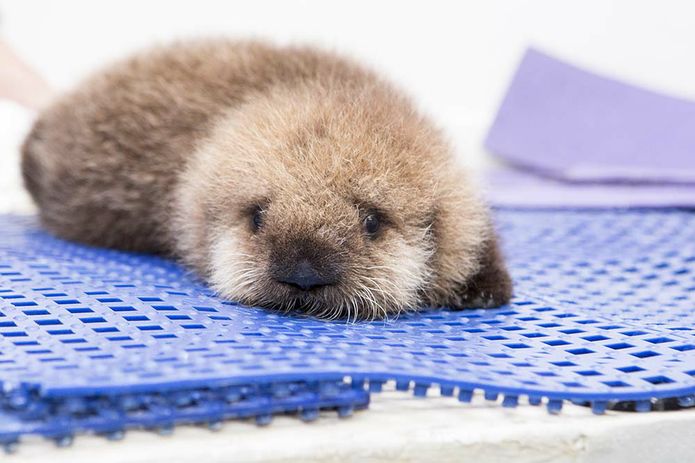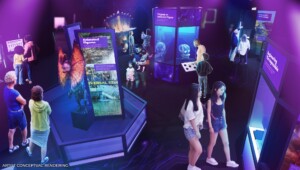The Ocean Project is now the largest network advancing ocean conservation, built on a base of unprecedented public opinion research on the ocean, climate change and environmental concerns. Bill Mott has grown it from a handful of aquariums into a network of around 2000 zoos, aquariums, education and conservation organisations in 80 countries worldwide.
In 2002, the Ocean Project launched World Oceans Day, an annual ocean awareness event now recognised by the United Nations. Its key aim is to improve the public’s understanding of the crucial role the sea plays as our planet’s life support system and the importance of keeping it healthy.
 Bill Mott, who has been working in ocean conservation for 27 years, spoke to Blooloop about the evolution of the Ocean Project, the birth of World Oceans Day and the ongoing conservation battle to address the issues facing the ocean’s health.
Bill Mott, who has been working in ocean conservation for 27 years, spoke to Blooloop about the evolution of the Ocean Project, the birth of World Oceans Day and the ongoing conservation battle to address the issues facing the ocean’s health.
"The ocean doesn't have anyone out there to speak for it"
“My initial interest in the ocean, like most of us working in this field, I think, started from a personal connection with the ocean, " explains Mott. "My grandparents lived near the seaside in the United States and I’d go and visit them in the summers and explore the tide pools and eat delicious seafood and enjoy the coast and the ocean.”
After graduating, Mott worked for over two years in Washington DC in marine environment protection through the National Marine Sanctuary Programme. He then spent three and a half years on a Federal Fisheries Reform campaign which was successful in reforming the Magnuson Act. The Act governs the management of marine fisheries in the United States. The campaign resulted in the Sustainable Fisheries Act of 1996, the only significant victory for conservation during the mid-1990s.
He says, “I came to the realisation that the ocean really doesn’t have much of a constituency out there to speak for it: to speak for the animals, to speak for conservation and protection of the ocean.”

So, he left Washington DC to help start what is now called The Ocean Project. By chance, there were several aquarium directors in the US and Canada who were interested in exploring what more could be done for ocean conservation.
“It was rather fortuitous and I ended up connecting with them, ” explains Mott. “The founding fathers and mothers were from the New York Aquarium; the New England Aquarium; the Vancouver Aquarium; the National Aquarium of Baltimore; the Monterey Bay Aquarium: a handful of aquariums that were instrumental in the formation of the Ocean Project. The Association of Zoos and Aquariums (AZA) was also helpful, as was a non-profit organisation called Seaweb. I ended up working for the first seven years half time with the Ocean Project and half time with Seaweb on sustainable seafood issues.”
Initially, the idea was to create a national advertising campaign that would raise awareness of the ocean environment among the American public. However, it soon became clear that the best way of realising the project’s ambitious goals was to help aquarium staff educate their visitors more effectively.

“So, we stepped back and decided we were going to create a strong foundation of research for everything we were going to take on, " says Mott. "So, we conducted national public opinion research. At the time, it was the most comprehensive research that had ever been done on the ocean in the US. Published in 1999, it was a wake-up call for a lot of aquariums in this country and worldwide about the lack of awareness among the public. The data pretty well proved that there was a very superficial knowledge about the ocean.”
This ground-breaking research became a springboard to help aquariums connect with the public. It encouraged them to get involved with local communities to help change behaviours and actually make a difference to their coastal environments.
World Oceans Day: Establishing a pattern of sustainability
World Oceans Day takes place on June 8th under the banner “Healthy Oceans; Healthy Planet.” It’s a call-to-action to individuals  and communities to change behaviours, do something meaningful on the day and then continue the pattern of sustainability throughout the year.
and communities to change behaviours, do something meaningful on the day and then continue the pattern of sustainability throughout the year.
Its adoption in 2002 was a unique opportunity for ZAMs (zoos, aquariums and museums) to engage visitors: “…regardless of where they live.
Everybody lives upstream from the ocean. And no matter where people are located in the world… we try to promote World Oceans Day as a real opportunity for people to make that ocean connection, from the air we breathe to the seafood that we may consume, to the recreational opportunities and economic impact of the ocean. It really is critical to each one of us, no matter where we live.”
World Oceans Day has steadily grown year on year, especially since its recognition by the UN. Last year there were 700 events in 70 different countries. Mott reports that activity on Twitter doubled compared with the previous year.
“Our role with World Oceans Day is to help encourage organisations around the world to mark the day in some special way, ” he says.
Last year, Mott’s team introduced downloadable event organisers’ action kits for three of the major issues  facing the ocean: plastic pollution and marine debris; climate change, ocean acidification and clean energy; and a third one on sustainable seafood to address overfishing.
facing the ocean: plastic pollution and marine debris; climate change, ocean acidification and clean energy; and a third one on sustainable seafood to address overfishing.
This year the Oceans Project will be partnering with new organisations, working to make a much greater push on plastics pollution problems.
"There are a lot of organisations working on these issues, ” he explains. “We don’t want to reinvent any wheels but what we try to do is promote the best efforts out there and engage our network of partners with those organisations.”
The latest comprehensive report summarising the project’s research initiatives since the late ‘90s has just been released and is downloadable from the website. Disappointingly, it shows that despite better opportunities for ZAMs to engage their visitors, there has been very little change in public awareness over time. While only the US has been surveyed so far, Mott speculates that this is probably true worldwide.“We don’t just want to increase awareness. We want to increase awareness for action – and try to provide people with positive ways of helping to engage with the solution. We’ll just have to continue pushing our partners to take some risks.”

Identifying innovative leaders
A year ago the Ocean Project launched the Innovative Solutions Grants+ Programme. Funded by the The National Oceanic and Atmospheric Administration, the scheme recognises innovative leaders in the zoo and aquarium world and provides them with a grant of up to $30, 000 a year. To maximise the award’s effectiveness, it comes with pro bono strategic communications coaching throughout the grant period. It also provides technical expertise to help catalyse peer to peer learning and sharing from the programmes zoos and aquariums are implementing.
“Each grant is provided to the zoos and aquariums to help them take some risks – really push the limits a little bit, " explains Mott. "These institutions are a little bit conservative and what we’re trying to do is provide them with the financial and strategic communication resources and coaching to help them engage the visitors in meaningful ways and report back to the larger  community so everybody can learn from their mistakes and successes."
community so everybody can learn from their mistakes and successes."
Mott and his team would like to extend the reach of World Oceans Day by working in different languages and with different cultures. The Ocean Project is still a comparatively small organisation. Future plans involve raising funding with the partners around the world to develop World Oceans Day as a meaningful, truly global event. The key to this is making it as culturally appropriate as possible to each community around the world.
“It’s our ocean; we all share it, and … that’s where we’re focusing a lot of our efforts – trying to make sure World Oceans Day is just that – global.”
Mott feels they have not really tapped into their broad and diverse network as much as they could, and that this is something to emphasise over the coming year. He adds: “ It’s an exciting job because we get to do a lot of new stuff every day in helping improve the situation for the planet as much as we can. It keeps me energised and optimistic about the future. It is daunting, there’s no doubt about that, seeing the issues we all need to address collectively.”
Working with teenagers is a huge opportunity
He is keen to stress that he is always optimistic. "I look at the successes some of the zoos and aquariums are having right now and at the market research pointing at real opportunities for engagement of young people – people between thirteen and twenty-five-year-olds in particular. I think my sense is that there’s more of a conservation consciousness with the younger generation and I’m hopeful about that as the start of a march towards a more sustainable future. Some of the old dogs… It’s like beating your head against a brick wall sometimes trying to change the behaviours of those of a certain age – not worth the effort.

Working with people when they’re teenagers in particular – that’s a huge opportunity for the zoos, aquariums and science museums. We’re really trying to capture their imaginations and develop their value-systems and make sure that conservation of the ocean and conservation and sustainability in general is just a way of life.”
He concludes: “We look at the issues holistically. We’re all citizens of the blue planet, essentially. It’s about protecting the health of the ocean for the future, not just for human society but for animals and life in the ocean.”
Image credits:
World Oceans Day Poster and logo from World Oceans Day. All other images king courtesy The Monterey Bay Aquarium, credits as below:
1. Southern sea otter pup #681, rescued and raised by the Monterey Bay Aquarium's Sea Otter Program, is now settling in to her new home at Shedd Aquarium in Chicago. ©Shedd Aquarium/Brenna Hernandez
2. Fish-eating anemone, Urticina piscivora, at the Monterey Bay Aquarium ©Monterey Bay Aquarium, photo by Tyson V.
3. The Sea Otter Program staff releasing a southern sea otter into the wild. © Monterey Bay Aquarium/Randy Wilder
4. Rare flower hat jellies are occasionally on exhibit in "The Jellies Experience." Here the unusual jelly is shown under blue light to highlight the jelly's fluorescence. ©Monterey Bay Aquarium/Randy Wilder
5. Visitors view the newly renovated Open Sea exhibit at the Monterey Bay Aquarium. © Monterey Bay Aquarium/Randy Wilder
6. Students participate in a variety of education programs at the Monterey Bay Aquarium. ©Monterey Bay Aquarium














